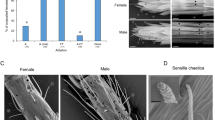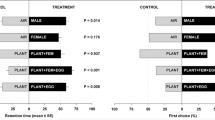Abstract
A host-recognizing kairomone responsible for the stinging behavior of the parasitic wasp, Dinarmus basalis, was studied. Fresh azuki beans coated with an acetone extract of the azuki beans, from which both emerged wasps and their host weevils were removed, elicited stinging behavior from female wasps. The kairomone is a mixture of saturated hydrocarbons and diacylglycerols, both of which are required for activity. The kairomone is composed of normal and methyl-branched hydrocarbons with carbon numbers ranging from 25 to 35, most of which are known as the hydrocarbon constituents of an oviposition-marking pheromone of the host azuki bean weevils, Callosobruchus chinensis. This indicates that D. basalis utilizes the oviposition-marking pheromone of its host weevils as a host-recognizing kairomone.
Similar content being viewed by others
REFERENCES
Caubet, Y., and Jaison, P. 1991. A post-eclosion early learning involved in host recognition by Dinarmus basalia Rondani (Hymenoptera: Pteromalidae). Anim. Behav. 42:977–980.
Caubet, Y., Jaison, P., and Lenoir, A. 1992. Preimaginal induction of adult behaviour in insects. Q. J. Exp. Psychol. 44B:165–178.
Doutt, R. L. 1959. The biology of parasite Hymenoptera. Annu. Rev. Entomol. 4:161–182.
Francis, G. W., and Veland, K. 1981. Alkylthiolation for the determination of double bond position in linear alkenes. J. Chromatogr. 219:379–384.
Fujii, K., and Wai, K. M. 1990. Sex-ratio determination in three wasp species ectoparasitic on bean weevil larvae, pp. 331–340, in K. Fujii, A. M. R. Gatehouse, C. D. Johnson, R. Mitchel and T. Yoshida (eds.). Bruchids and Regumes: Economics, Ecology and Coevolution. Kluwer Academic Publishers, Dordrecht, 407 pp.
Islam, W. 1994. Effect of host age on rate of development of Dinarmus basalis (Rond.) (Hym., Pteromalidae). J. Appl. Entomol. 118:392–398.
Islam, W., and Kabir, M. H.1995. Biological control potential of Dinarmus basalis (Rond.) (Hymenoptera: Pteromalidae), a larval-pupal ectoparasitoid of the pulse beetle Callosobruchus chinensis ( L.). Crop Protection 14:439–443.
Jones, R. L., Lewis, M. C., Bowman, M. C., Beroza, M., and Berl, B. A. 1971. Host-seeking stimulant for parasite of corn earworm: Isolation, identification, and synthesis. Science 173:842–843.
Kojima, T. 1983. Qualitative Analysis, pp. 131–171, in Y. Masada, and T. Kojima (eds.). High Resolution Gas Chromatography. Kagaku-dojin, Tokyo, Japan, 271 pp. (in Japanese).
Lockey, K. H. 1978. Hydrocarbons of adult Tribolium castaneum Hbst. and Tribolium confusum Duv. (Coleoptera: Tenebrionidae). Comp. Biochem. Physiol. 61B:401–407.
Mattson, F. H., and Volpenhein, R. A. 1961. The use of pancreatic lipase determining distribution of fatty acids in partial and complete glycerides. J. Lipid Res. 2:58–62.
Nishimura, K. 1997. Host selection by virgin and inseminated females of the parasitic wasp, Dinarmus basalis (Pteromalidae, Hymenoptera). Funct. Ecol. 11:336–341.
Nishimura, K., and Johon, G. C. 1996. Sex allocation of three solitary ectoparasitic wasp species on bean weevil larvae: Sex ratio change with host quality and local mate competition. J. Ethol. 14:27–33.
Sakai, A., Honda, H., and Yamamoto, I. 1986. Oviposition marking pheromones of two bean weevils, Callosobruchus chinensis and Callosobruchus maculatus. J. Pestic. Sci. 11:163–168.
Sanon, A., Quedraogo, A. P., Tricault, Y., Credland, P. F., and Huignard, J. 1998. Biological control of bruchids in cowpea stores by release of Dinarmus basalis (Hymenoptera: Pteromalidae) adults. Environ. Entomol. 27:717–715.
Suzuki, T., Nakakita, H., and Kuwahara, Y. 1988. Defensive secretions and hydrocarbons of two Tribolium species and their hybrids (Coleoptera: Tenebrionidae). Appl. Entomol. Zool. 23:329–337.
Takahashi, S., and Takabayashi, J. 1984. Host selection behavior of Anicetus beneficus Ishii et Yasumatsu (Hymenoptera: Encyrtidae) II. Bioassay of oviposition stimulants in Ceroplastes rubens Maskell (Hemiptera: Coccidae). Appl. Entomol. Zool. 19:117–119.
Tanaka, K., Ohsawa, K., Honda, H., and Yamamoto, I. 1981. Copulation release pheromone, electin, from the azuki bean weevil (Callosobruchus chinensis L.). J. Pestic. Sci. 6:75–82.
Verma, R. 1990. Host habitat location and host location by Dinarmus basalis, a parasite of bruchids of stored legumes. Ind. J. Exp. Biol. 28:179–184.
Verma, R. 1991. Life-history and some aspects of biology of Dinarmus basalis (Hymenoptera, Pteromalidae), a parasite of stored legume bruchids. Acta Entomol. Bohemoslov. 88:359–366.
Vincenti, M., Guglielmetti, G., Cassani, G., and TONINI, C. 1987. Determination of double bond positions in diunsaturated compounds by mass spectrometry of dimethyl disulfide derivatives. Anal. Chem. 59:694–699.
Vinson, S. B. 1985. The behavior of parasitoids, pp. 417–469, in G. A. Kerkut and L. I. Gilbert (eds.). Comprehensive Insect Physiology, Biochemistry and Pharmacology. Vol. 9. Behaviour. Pergamon Press, Oxford, 735 pp.
Author information
Authors and Affiliations
Rights and permissions
About this article
Cite this article
Kumazaki, M., Matsuyama, S., Suzuki, T. et al. Parasitic Wasp, Dinarmus basalis, Utilizes Oviposition-marking Pheromone of Host Azuki Bean Weevils As Host-Recognizing Kairomone. J Chem Ecol 26, 2677–2695 (2000). https://doi.org/10.1023/A:1026425407150
Issue Date:
DOI: https://doi.org/10.1023/A:1026425407150




